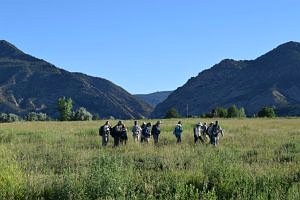By Riley Reed
What is a bioblitz?
Last week as a CNHP intern I had the opportunity to participate in two bioblitzes in Rifle and Carbondale, Colorado! A bioblitz is when a team of scientists travels to a designated area to best identify all the flora and fauna species. The scientists are given a twenty four hour period to find, identify, and document all the species that they can. Pictures or live samples are taken of each species that is documented. The purpose of the bioblitz is to gather information about the biodiversity of the area. This can help landowners manage their property more efficiently and promotes the best land use practices. It can also bring attention to any threatened and endangered species that are on the property.
First time? Won’t be your last!
For many of the interns and volunteers, including myself, it was our first time learning about and helping with a bioblitz. It was a great learning opportunity that allowed us to get hands-on experience in a relaxed and fun manner. Many different fields of natural resources’ work were covered, such as zoology, botany, restoration ecology, and human dimensions. All of the CNHP scientists were very helpful and passionate about spreading their knowledge and teaching the interns and volunteers.
Where did we go?
A large group from CNHP consisting of zoologists, botanists, interns, and volunteers left Fort Collins and headed west to the bioblitz location on a ranch in Rifle. The Ranch had a wide range of habitats that provided a high biodiversity rate relative to the size of the property. The data that was collected on the property was achieved through a variety of different methods. Birds and other wildlife were spotted during flash surveys of the property; camera traps were also set up at various locations. Bats were documented using a sonogram that was set up near the pond at night. Insects were captured with insect nets and a UV light trap at night. Fish were documented with the help of Colorado Parks and Wildlife and one of their fish shocking experts. (I would like to note that no fish were hurt during the fish shocking studies.) Trees, forbs, and grasses were identified and keyed out by the botany teams by walking the property. One specialist group of individuals from the botany team focused their entire time searching and identifying mosses and lichens. Once all of the species were identified to the best of our ability, we packed up and headed to our next location 45 minutes from Rifle around Carbondale.
Change it up?
The Ranch in Carbondale offered a good change of scenery and a new challenge to identify all the species on this section of land. Methods that were used in Rifle were repeated with slight modification to suit the new landscape. The zoologist team had wonderful success catching and identifying a wide variety of new butterflies, and the botany team had great achievements monitoring a rare species of plant known as good-neighbor bladderpod.
Overall, this was a life changing event, and I look forward to participating in future bioblitzes.





